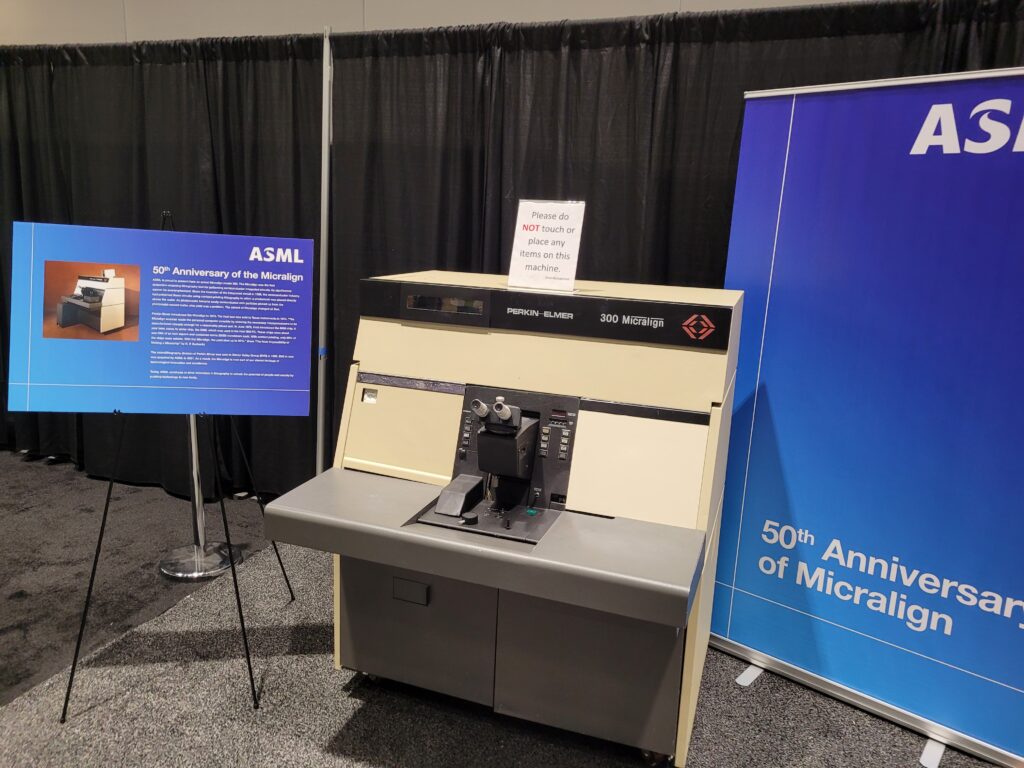Bright and early, the talks begin at 8:00 am. From Mark van de Kerkhof of ASML, and then Joost Bekart of imec, we got two updates on EUV pellicles. The composite (metal-silicide) pellicles are the second-generation pellicle after polysilicon, but they are stalling out with transmission near 90%. Higher transmission requires thinner pellicles, which is quite difficult. The low transmission also limits the highest power that can be used (absorption heats up the pellicle, and if the heat cannot be removed fast enough the temperature rise will ultimately destroy it). Slow progress can be expected, but it seems that increases in source power will outpace increases in transmission. That is why the carbon nanotube (CNT) pellicle, first proposed by imec in 2015, is so interesting. It has extremely high transmission (> 97% after being annealed to remove contaminants) and so can withstand very high source power (> 1000W). It’s drawback is the gradual thinning of the pellicle with use as the carbon (activated by all the EUV light) reacts with hydrogen gas, which ASML puts in the system specifically to remove carbon deposits that might occur inside the tool! An interesting dilemma, and I will enjoy watching progress towards a solution.
Back in the metrology session Yoshihiko Fujimori of Nikon introduced a new tool for high-density CD measurements on the wafer. The paper was sparse on some important details, but the tool reminded me of a crystallography setup, measuring the diffraction pattern of the whole patterned wafer with variable wafer and detector angles. (The name AMI-5700, along with a marketing picture, indicated at least close to commercial readiness.) A full wafer, up to 100,000 points, can be measured in a couple of minutes. That means about a 1 mm spatial resolution, and it is obviously limited to periodic structures (and so memory chips). The key idea appears to be correlating various “signals” coming from the detected diffraction pattern with SEM-based measurements of CD in a previous calibration step. Then a measurement of that signal across the wafer is used to infer CD variation across the wafer. Like all such techniques, the two key questions are sensitivity to noise, and sensitivity to other systematic variations (such as an underlying film thickness) that might also impact the signal being monitored. These problems have bedeviled other similar attempts in the past.
Gian Lorusso of imec gave a fast-paced overview of the metrology of thin versions of the dry Lam Research resist. As Gian has shown in the past, low signal-to-noise ratio CD-SEM images that often result from very thin resist patterns can make accurate metrology difficult (even when using state-of-the art metrology software from Fractilia!). The main message from this paper is the happy fact that the Lam dry resist offers fairly high material contrast in the SEM, making measurement of even 10 nm thick resist patterns acceptable at normal SEM settings (such as 16 frames of averaging).
On the topic of resist shrinkage in the CD-SEM (a problem that never goes away, no matter how much we ignore it), Musaki Sugie of Hitachi offered an interesting combination of ideas. As many SEM vendors have demonstrated, going to 100 V reduces shrinkage, though it increases the noise in the image. (Ran Alkoken of AMAT showed their 100 V CD-SEM in the following talk.) This voltage was coupled with an optimized scan speed to minimize charging and to prevent CD measurement repeatability from suffering. An interesting additional idea in the talk was to average together 32 sub-sections from a large 1-frame image of lines and spaces to measure CD with the precision of a 32-frame image and the shrinkage of a 1-frame image. Information such as linewidth roughness or local CDU cannot be obtained, but for the one goal of finding the CD with minimal shrinkage, the approach may work. As an aside, he noted that metal oxide resist (that is, Inpria) has 3X less shrinkage than chemically amplified resists for EUV.
After lunch I saw a few papers from imec, updating prior efforts. Andreas Frommhold used Mark Maslow’s concept of Tail CD (measured mean +/- 3sigma of the contact hole distribution) as a predictor of merged contact hole rates. In this case, the CD being measured was the gap between the holes, and the mean – 3sigma value is correlated with rates of merged holes. I know from experience, however, that exactly how one defines and measures this hole-to-hole gap CD is quite critical. Lieve Van Look of imec continued her very detailed work on local MEEF (mask error enhancement factor) and its impact on LCDU, bringing the concept of MEEF into the era of stochastics. Her collection of papers on this topic so far represents the definitive work on the topic.
The poster session in the evening was, thank goodness, in a massive hall with plenty of room to work your way among the posters without being jammed in by the crowds (which frequently happens at other conferences). Alas, being a long-time participant in this conference meant that my mean free path (the average distance traveled before running into someone to talk to) was very small. I didn’t see many posters. For all the poster presenters out there – please turn in a manuscript of your paper so I can read them!

